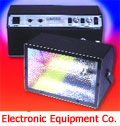Getting it Right, the First Time
- Published: December 31, 2004, By Debbie Donberg, Associate Managing Editor
Product Focus
Sorting good from bad is a pretty basic part of any manufacturing process, and according to Bob Chiricosta, marketing manager at Cognex, Natick, MA (cognex.com), that’s why most converters begin the process of investigating web inspection.
"They’re simply sorting good from bad, and they think that’s wonderful," says Chiricosta, "but then they begin to realize they can use this tool to stop making the bad material. And they can increase their yield, which is where they really make money, because they no longer make good and bad material—they make all good material. If they get a streak, they can stop it before they make thousands of linear yards of material with a streak in it, because they’re going to know it instantly."
That’s why, says Chiricosta, "web inspection is not only increasing, it’s exploding!"
The hot niche of security is making inroads at Unilux, Saddle Brook, NJ (unilux.com), explains president Mike Simonis. "In UV security printing, where they’re adding phosphorus into the inks, they can’t see the web with visible light, so they had no way of inspecting it before unless they pulled it off. A UV strobe light will allow them to inspect this printed matter at full production speeds."
Features and more features are what Lance Shumaker’s customers are looking for, says the president of Advanced Vision Technology, Atlanta, GA (avt-inc.com). That’s because the consumer product companies are asking for more. "One example is on-line color measurement," says Shumaker. "Their customers don’t want you to just take a spectrophotometer reading at the end of the roll; they want to know throughout the run what the color’s doing and what the consistency is." He adds, "Another feature our customers want is automatic pre-registration, especially in CI flexo. Also, plate pressure control at the makeready stage where you can get plate pressure and anilox pressure automatically and faster than you can do it manually." Shumaker predicts makeready for inking eventually will be the "third leg of the stool." "We have preregistration and plate pressure control. When you add makeready for inking, you’ll have all the components to make the press a closed loop process control system and have much more consistency over the print quality."
The future of web inspection is better and better software, Chiricosta believes, meaning "trend analysis over days, weeks, months. Are you getting more of a particular kind of defect, little gels or black specs, etc., during the day, during the night, on Mondays or Tuesdays, second shift, first shift, summer or winter? Do you get gels when you run certain types of plastic, perhaps at a certain temperature?" The software even allows paper mills to send a converter a record of defects to help slitter or rewinder operators plan ahead.
Scott Durfee, district manager at Maxcess Intl., which includes Fife Corp., Oklahoma City, OK (fife.com), says web inspection customers today are looking for more reliable systems, higher resolution capability, systems that are easier to use, and auto registration. "A number of things are driving these changes, including a higher level of quality expectations from customers, increased cost of raw materials, especially in plastics due to the price of oil, and an increase in process work, although this is beginning to taper off."
Both Durfee and Shumaker agree a crucial segment for web inspection is pharmaceuticals, where a missing character on a label can have dire consequences. This is where 100% inspection is required, Shumaker notes. "In most wide web uses, you’re not going to stop a press, so sampling is suitable. But pharmaceutical labels must be perfect."
Ron Suenram, product manager for video web inspection at Fife, says today’s web inspection includes smaller video web inspection systems that are completely self-contained and can be moved easily between presses. "Also, quality is higher, components are more robust, and new technology like cameras and lighting components provide a more accurate depiction of the moving web."
Of web inspection systems in general, Durfee says, "Most converters are dealing with lower profit margins than ever before; they need to find a way to produce less scrap." And sorting good from bad is only the beginning.

See our January New Product Digest for this and other new web inspection products.
Restrictions of time and space limit the number of companies, products, and trends that we can discuss in these reports. For additional information, see PFFC’s features and departments each month, consult the June Buyers Guide, and check our online archives.




